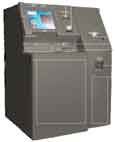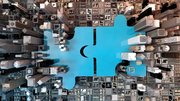News
A Whole New World of ATM Options
The ATM world's move toward Triple DES encryption is a painful process for many deployers, networks and others. For some ATM manufacturers, however, it may present a potential for new business.
October 26, 2003
One man's agony is another man's opportunity.
Witness the ATM world's move toward Triple DES encryption. The process is a painful one for many deployers, networks and others. For some ATM manufacturers, however, it may present a potential for new business.
"We've been getting calls from banks out of nowhere," said Tony Park, chief executive of NexTran Industries, who claims that financial institutions facing decisions about whether to upgrade aged ATMs or purchase new machines to comply with Triple DES regulations are "more open-minded now" when it comes to considering alternatives to their traditional ATM vendors.
|
NexTran, a partially-owned subsidiary of Korean manufacturer Chungho ComNet, and other manufacturers whose primary focus has been the retail market are introducing products developed specifically for financial institutions. They hope to lure at least some of them away from NCR and Diebold, the two companies that supply the overwhelming majority of ATMs to banks in the United States.
NexTran was recently contacted by a small financial institution in Oregon interested in replacing its 27 ATMs, Park said.
"They got a quote from the vendor for $4,000 each to upgrade, and they didn't think it was going to be worth it," he said. "They were calling us and several other manufacturers to get quotes on prices for new ATMs."
NexTran's ComNet 8000 is its most FI-friendly model, Park said, with features such as a 12.1-inch color screen, a motorized card reader and the capability to hold up to 12,000 notes. The PC-based unit comes in either a walk-up or a through-the-wall configuration.
At a crossroads
"We've got a relatively short time togo out and churn the base," said Doug Sholes, Triton'smanager of financial institution sales, alluding to guidelines that call for the U.S. installed ATM base to become Triple DES compliant over the next two to four years.
 |
NexTran's ComNet 8000 |
Triton is targeting FIs with the FT5000, a through-the-wall unit, and the RL5000, a walk-up, both rolled out earlier this year. (See related story Triton refines the product rollout)
Danny Langston, director of sales for GTI, said FIs have three choices when it comes to Triple DES: upgrade existing machines, at a cost of $3,000 to $7,000 which "still leaves them with the same expenses they've had in the past," including maintenance costs, which tend to rise as ATMs age; replace the old ATM with a new one made by the same vendor, at a cost of $18,000 to $25,000; or swap it for a new ATM that "offers the same functionality for half the price."
With an ATM made by GTI or another retail-oriented manufacturer, Langston said, FIs will save on maintenance costs and generally use dial-up or IP communications versus the more costly leased line connections common with older ATMs.
|
GTI's TTW 2000, which it introduced at the 2002 Retail Delivery Show (RDS), was created after FIs showed interest in its predecessor, the TTW 1000. GTI redesigned the TTW 1000's rear door for increased security, added a Level 1 vault option and boosted note capacity to 2,000 notes. Later this year, Langston said, GTI will debut the TTW 3000, a PC-based version.
Like Langston, Eric Sternberg, vice president of marketing for Tranax Technologies, stressed the overall cost of ownership. "The cost of maintenance rises over time. These older machines can be quite expensive to operate," he said, noting that many FIs own 10- to 20-year-old ATMs that must be either upgraded or replaced for Triple DES.
Tranax will roll out a new model called the MiniBank 5000 by year's end. The PC-based machine, which was previewed at RDS 2002, will come in a variety of configurations including a through-the-wall version.
Brad Zerman, president of Chicago-based start-up Qualtex, said his company tweaked its WeatherMaster through-the-wall ATM earlier this year, adding a sunlight-viewable monitor and doubling the note capacity from 1,000 to 2,000 notes after it began receiving inquiries from financial institutions. (See related stories Midwest Bancard spins off ATM business, intros new ATM and Taking on "the Ts")
Zerman said many of the FIs are interested in lower-cost alternatives for off-premise deployments. The WeatherMaster is easier to deploy and offers more flexibility, he said, because unlike most through-the-wall ATMs, it does not require a stand.
Some of these banks have their commercial customers asking them for ATMs for their retail locations, but they don't have an off-premise program and can't afford to do one with an NCR or a Diebold machine," Zerman said.
Next year, Qualtex plans to make a stronger effort to win FI business by rolling out a PC-based version of the WeatherMaster with a larger monitor, Zerman said.
All of these ATMs -- including the models still in the works -- generally cost a third to a half less than the machines more commonly deployed by FIs. The manufacturers say they offer features and functionality similar to the more traditional, bank-oriented models.
The deposit difference
In some cases, however, manufacturers seem to be taking a "wait-and-see" attitude toward features like depositories. GTI's Langston noted that offering a depository can add thousands of dollars to the cost of an ATM -- while only about 10 percent of ATM transactions involve deposits.
 |
Triton's T5000 |
NexTran's ComNet 8000 currently offers a depository capability. While Sternberg hinted that a deposit option would be available on the MiniBank 5000, he preferred to keep details to a minimum since the machine has not yet been released.
While neither Triton's RL5000 nor FT5000 currently offers a depository, Sholes expects that to change next year. "I think we must have it to be a full-service provider," he said.
Also in 2004, Triton plans to introduce versions of the FT5000 with a motorized card reader and stainless steel bezel and keypad, largely to appeal to the international FI market. In 2004's first quarter, Sholes said, Triton will release an XFS-based software package.
Speaking the same language?
Another "wait-and-see" item is NCR/Diebold emulation, the ability for machines to "talk" to networks using the same message protocols used by those two vendors.
The issue is primarily a concern for ATMs with leased-line connections to a network, and most seem to agree that FIs increasingly are migrating toward IP. "Anybody who is upgrading is heading in that direction," said Sholes.
Nonetheless, Triton, NexTran and Tranax are all working to add the capability to their machines. Tranax's Sternberg called it a "critical" feature. "You must have it to succeed," he said.
Getting to know you
Those issues seem minor, however, in light of what all agree is their biggest challenge: FIs' inherent conservatism, which makes them reluctant to leave the comfort zone of their longtime vendors. All of the manufacturers are attending trade shows and otherwise trying to raise their profile in the FI world.
"Diebold and NCR have done a wonderful job of establishing those relationships out there, and selling is a relationship business," said Bob Bucceri, a general partner in Chaddsford Planning Associates, a consultant to NexTran.
Triton and Tranax in 2001 introduced products that they hoped would pique the interest of FIs. After a decidedly lukewarm reception for both Triton's 9800 and Tranax's MiniBank 3000, the manufacturers regrouped and created products they feel better address the needs of FIs. (See related story Banking on new markets)
"We have to prove ourselves; we know that," said Sternberg. "We'll do it by showing that we have solid products that work as well as any of the other products out there."
The 9800 "was not the product we had hoped it would be," said Sholes, "but it was not a product built from the ground up for financial institutions. We learned a lot from it, and we think we've got the right product now."
"NCR and Diebold have demonstrated they have staying power," Sholes said. "We know that a manager making a decision for Triton is, in a sense, taking a risk."
In Triton's case, he said, any risk is mitigated by the financial backing of parent Dover Corporation. Triton also has proven itself by selling more than 80,000 units worldwide over the past eight years, he said.
The little guys
The manufacturers seem to agree that smaller FIs -- especially credit unions and community banks -- offer a logical entry into the market.
In their quest to compete with the marketing dollars and brand recognition of larger banks, smaller FIs are often more willing to offer services that "the bigger banks won't touch" including advanced ATM functionality, Bucceri said. "They want to be nimble and react quickly to changes in the market. We have products that can meet those needs."
GTI's Langston predicted that ATMs will become a more critical channel for smaller FIs that serve customers in areas targeted for expansion by some of the country's largest banks, like Bank One, Wachovia and Bank of America.
"You've got small guys trying to compete with banks like BofA that are coming into their service areas and building a castle," Langston said. "They need to add services to compete, but they can't afford to build a branch."
Machines Diebold:13,560 ATMs shipped in U.S. in 2002 (estimated), down 5.8 percent from 14,400 (also estimated) in 2001 |
Smaller FIs may feel underserved by the traditional ATM vendors , Sternberg said. A former Hewlett-Packard employee, he pointed out, "HP took a lot of business from IBM by devoting more attention to the smaller accounts. I think to some extent you see the same kind of vulnerability in the financial services world."
There are some 20,000 credit unions and community banks in the U.S., said Sholes. Many of them have only a single ATM "because it's been difficult for them to cost justify ATM ownership before."
May the (sales) force be with you
Phil Suitt, president and chief executive of ATM Ventures, a Houston-based company that recently completed beta tests with both Triton's FT5000 and RL5000, said that the Texas credit union involved in the test already plans to buy FT5000s for two new branches it is building and possibly more Tritons for off-premise deployments.
"You'd be surprised how many credit unions and smaller banks don't do off-site ATMs because of the cost," Suitt said.
An ATM deployer for six years, Suitt has been focusing on the FI market for the past three years. "The introduction of this new equipment is going to open up a lot of new opportunities for them," he said.
Suitt's company is one of more than a dozen selected to sell Triton's FT5000 that will attend an organizational conference at the end of this month, Sholes said. Among the ranks are companies that have previously sold Triton hardware -- and those which have not, but which have sold items like vaults and pneumatic tubes to FIs or provided other services, Sholes said.
Like the other manufacturers, Triton is modeling the sales channel for its new, FI-oriented products on the VAR (or value-added reseller) approach long utilized by NCR and Diebold.
Indeed, Qualtex's Zerman hopes to find new distributors among the ranks of resellers he said have recently been displaced by the larger vendors.
"I've heard that some of the manufacturers have been eliminating their relationships with their smaller distributors," Zerman said. "So they're disgruntled now because they have to get their product from their competitors. I think they may be more open to selling new products."
Other companies with ties to financial institutions, such as armored carriers, also are expressing interest in supplying hardware, Zerman said. "They're looking at cross-selling to their customers."
"We're looking for companies that are 100 percent focused on financial institutions," Sholes said. "We don't want somebody who says, 'I'm going to call on two c-stores today, and there's a credit union on the way so I'll hit them too.'"
Triton is also building a nationwide "service grid," said Sholes, to ensure that technicians trained on the new hardware are available to provide service and maintenance to all ATM owners who need it.
Service is crucial, Sternberg agreed, noting that the capability to provide fast service is a key consideration in Tranax's qualification process for potential resellers of the MiniBank 5000. "You've got to be able to respond quickly. An ATM is part of a bank's core business; it's not just an additional service to the customer, like it is at a c-store."
Despite the considerable challenges they face, retail-oriented manufacturers possess knowledge that can help FIs, Sholes said.
"You might have a deployer with one of our machines at a c-store doing 200 to 300 transactions a month and still making a profit. A credit union across the street might be doing 2,000 transactions a month and operating at a loss," he said. "With our blended understanding of the two markets, we can help the financial institution make the ATM a more valuable part of its estate."
Included In This Story
Triton Systems
Triton FI based products • NO Windows 10™ Upgrade • Secured locked down system that is virus/malware resistant • Flexible configurations - Drive-up and Walk-up • Triton's high security standards • NFC, anti-skim card reader, IP camera and level 1 vaults are all options • Triton Connect monitoring • Lower cost
Diebold Nixdorf
As a global technology leader and innovative services provider, Diebold Nixdorf delivers the solutions that enable financial institutions to improve efficiencies, protect assets and better serve consumers.


















